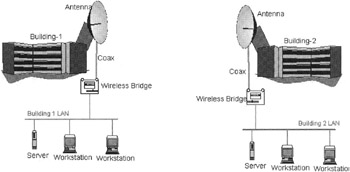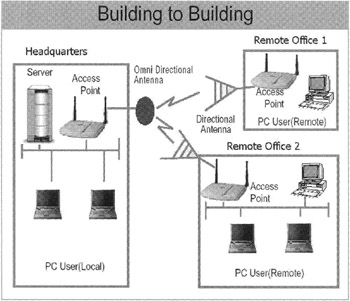Chapter 9: Bridging Buildings
|
| < Day Day Up > |
|
Overview
Sometimes end-users who are located in geographically separated buildings need to be connected to the same network. Wirelessly bridging using Wi-Fi technology provides a perfect way to connect two buildings. As long as the two buildings are within a few miles of each other, and there is a clear line of sight between the locations to be bridged, a wireless connection (bridge) between the buildings will allow all network users to access the same network system. Note, however, that to provide adequate signal levels, special antennae may be required.
A Wi-Fi bridge is essentially a media access control (MAC) level wireless access point that's configured so it can "bridge" or pass incoming wireless packets to one or more corresponding bridges. Wireless bridges allow network managers to quickly and inexpensively extend a wireless LAN across intervals ranging from several hundred feet/meters to a mile/kilometers or more. With specialized antennae, the distance could be up to 5 or 6 miles (8 or 9 kilometers). And new antenna technology may enable that distance to grow to more than 30 miles (48 kilometers).
| Note | Although wireless bridges can provide line-of-sight bridging at greater and greater distances, in the U.S., the FCC limits the maximum distance a wireless bridge is allowed to span to 25 miles / 40.2 kilometers. And in European countries the maximum is 6.5 miles / 10.5 kilometers. |
Bridging is not covered, per se, under the 802.11 series of standard. Yet the standards do allow a wireless bridge system to be built that can span miles/kilometers at high data rates and can turn WLANs into WANs (wide area networks), if necessary. Network administrators, fed up with the high recurring costs associated with leased lines and the expense that comes with running fiber underground, especially in areas where right-of-way issues exist, eagerly exploit wireless bridge technology to extend their networks beyond the indoor network.
The quickest and least expensive bridge is the point-to-point wireless bridge. This type of bridge only requires a couple of access points, which are configured as either a router or a bridge. Then just attach an external double gain antenna to each, and place each in a position where the external antennae are visible to each other. This type of set-up provides a connection between networks in different buildings. It is a good choice in a campus environment, where specific areas are close to the campus yet are without fiber optic connectivity to the backbone. Buildings with a wired network within them can use wireless connectivity to get to the campus backbone network; but the distances for this type of set-up are limited, and you must have "clear line-of-sight" between the antennae.

Figure 9.1: Point-to-Point Bridging.

Figure 9.2: An example of how a building-to-building bridge might be used.

Figure 9.3: As this graphic shows, you needn't limit the bridge to only two buildings.
To deploy a building-to-building bridge application, all you need is a wireless bridge at each location. Each bridge is connected to the building's network using traditional wire. Antennae are then installed on each wireless bridge to connect the two buildings' local networks.
In multipoint bridging, a subnet on one LAN is connected to several other subnets on another LAN via each subnet's AP. For example, if a computer on Subnet A needed to connect to computers on Subnets B, C, and D, Subnet A's AP would connect to B's, C's, and D's respective APs.
|
| < Day Day Up > |
|
EAN: 2147483647
Pages: 273